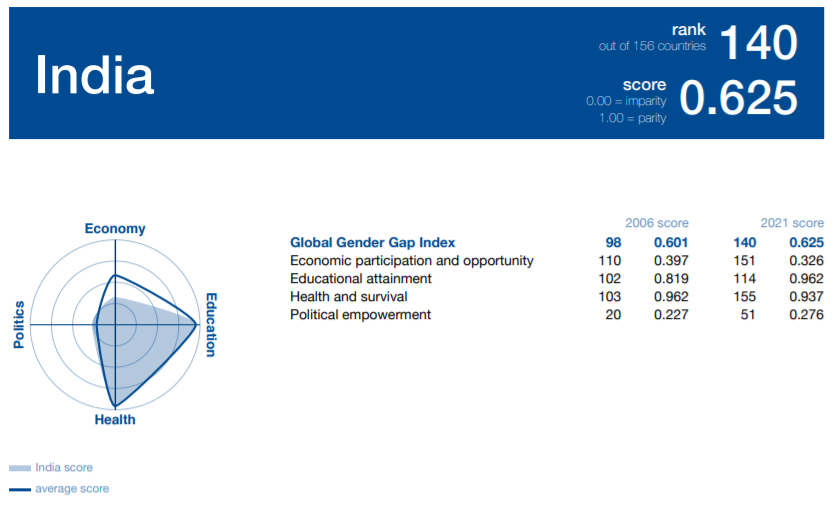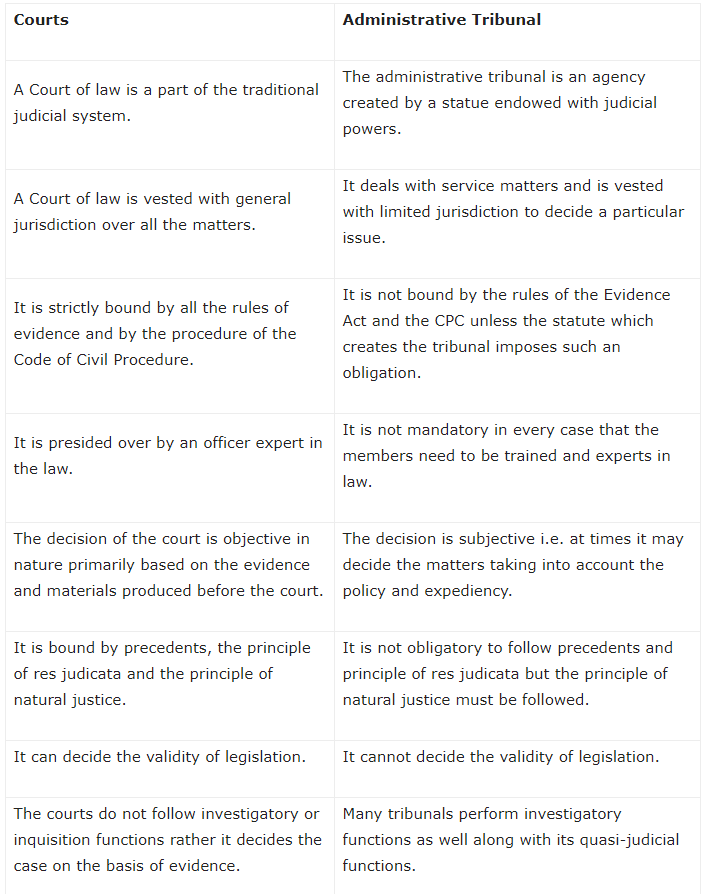Global Gender Gap Report 2021
2021 MAY 4
Mains >
Society > Role of women > Women and Child issues

IN NEWS:
- India has slipped 28 places to rank 140th among 156 countries in the World Economic Forum’s Global Gender Gap Report 2021.
GENDER GAP REPORT:
- The Global Gender Gap Index benchmarks the evolution of gender-based gaps among four key dimensions and and tracks progress towards closing these gaps over time.
- The four dimensions are:
- Economic Participation and Opportunity
- Educational Attainment
- Health and Survival
- Political Empowerment
- The report measures women's disadvantage compared to men. The highest possible score is 1 (equality) and the lowest possible score is 0 (inequality).
FINDINGS OF 2021 REPORT:

- The data show that it will take 135.6 years to bridge the gender gap worldwide and the pandemic has impacted women more severely than men.
- By slipping to 140th among 156 countries in the report, India became third-worst performer in South Asia. (The country had ranked 112th among 153 countries in the Global Gender Gap Index 2020.)
- The report said that India had so far closed 62.5% of its gender gap.
- Most of the decline occurred on the political empowerment subindex, where India regressed 13.5%, with a significant decline in the number of women ministers (from 23.1% in 2019 to 9.1% in 2021).
- In the economic participation and opportunity subindex, India’s gender gap widened by 3% this year, leading to a 32.6% gap closed till date.
- The estimated earned income of women in India is only one-fifth of men’s, which puts the country among the bottom 10 globally. I.e. For every five rupees that men earn in India, women earn only one.
- India’s ranking on the health and survival dimension is among the five worst performers. India’s gender gap is at 93.7 per cent, which means women have 6.3 per cent less chance of surviving or getting healthcare as opposed to men.
WHY INDIA IS SLIPPING:
- COVID pandemic: The pandemic has amplified the gender bias in India. Women are bearing a disproportionate amount of the burden that the imposition of lockdowns and shrinking of economic opportunity has created. For instance, in the “The Inequality Virus”, Oxfam India reported 17 million women lost their job in April 2020.
- Social conditioning: The nurturing in a patriarchal society like India does not factor in the elements of gender equality and sensitivity. Women are considered subordinate to men and are stereotyped as the caretaker of family.
- Economic dependence: The absence of education and employment facilities for women curtails their ability to sustain themselves economically. This perpetrates a cycle of poor socio-economic outcomes for women.
- Political hesitancy: Women in India have performed remarkably in the Panchayat level due to reservation of 33% seats to them. However, successive governments have been hesitant to pass the Women's Reservation Bill which aims to reserve 33 percent seats in Lok Sabha and all state legislative assemblies for women.
- Weak law enforcement: Despite having several laws to protect and empower women, their enforcement remains weak. For eg: Despite having a law prohibiting sex selective abortion, between 2013 and 2017 about 460,000 girls in India were ‘missing' at birth each year.
- Delayed justice: With over 3.4 crore pending cases, ours is one of the slowest judicial systems in the world. Hence, women suffering from gender discriminations and violence have no avenue for grievance redressal.
- Deficit of basic infrastructures: The lack of sufficient toilet facilities, limited transport facilities and long distances to workplace & schools increase the vulnerability to violence against women.
- Glass ceiling at workplaces: Due to preference for men and difference in pay, women find it difficult to progress in their career. This is evident from the fact that only 14.6 per cent women occupy senior managerial position in India, and only 8.9 per cent when it comes to top management. This in turn results in low labour force participation rates among women.
- Digital divide: The latest NFHS report showed that only 42% of Indian women surveyed have ever used the internet, compared with 62% of men. Hence, women are being marginalized from the benefits of a digital India.
MAJOR GOVERNMENT INITIATIVES FOR WOMEN:
1. Economic Participation and Opportunity:
- Gender Budgeting
- Rashtriya Mahila Kosh: provides micro-credit to poor women for various livelihood support and income generating activities
- Mahila-E-Haat: A bilingual online marketing platform that leverages technology to help aspiring women entrepreneurs.
- Rajiv Gandhi National Creche Scheme
- Scheme of Working Women Hostel
2. Health and Survival:
- Beti Bachao Beti Padhao Scheme
- UJJAWALA: A Comprehensive Scheme for Prevention of trafficking and Rescue, Rehabilitation and Re-integration of Victims of Trafficking and Commercial Sexual Exploitation
- SWADHAR Greh (A Scheme for Women in Difficult Circumstances)
- NIRBHAYA fund
3. Educational Attainment:
- Mahila Shakti Kendras: to empower rural women with opportunities for skill development, employment, digital literacy, health and nutrition.
- Knowledge Involvement in Research Advancement through Nurturing (KIRAN) Scheme for promoting women in science.
4. Political Empowerment:
- Constitutionally mandated 33 percent reservation for women in local self-government bodies.
WAY FORWARD:
- Gender sensitization: Long term strategies are essential to bring about large-scale gender sensitization. Sensitisation should be made a part of the school curriculum from primary school onwards.
- Empower the community: There should be strong community driven measures to address the problem of culture of misogyny, aggressiveness and normalised gender discrimination.
- Gender sensitive infrastructure: Public spaces and workplaces should be made safer for women. For the same, government should boost its efforts such as women police stations, pink police, better surveillance systems.
- Effective law enforcement: Government should create legislations that empowers women, such as those assuring reservations in politics and ensure the effective equal pay for all and protection of women in society. This can begin with a review of workplaces to ensure implementation of the Sexual Harassment of Women at Workplace (Prevention, Prohibition and Redressal) Act, 2013.
- Faster delivery of justice: The government should look at establishment of courts specializing in crimes against women to expedite justice.
CASE STUDY: RWANDA & POLITICAL PARTICIPATION OF WOMEN:
- Rwanda is ranked seventh in the World Economic Forum's gender gap report. This is an outcome of the country’s efforts towards female advancement.
- The Rwandan constitution, written and ratified in 2003, provides a gender quota mandating that women hold no less than 30 percent of political seats. As a result, Women make up 62 percent of Rwanda’s national legislature, far more, proportionally, than any other country.
- Some of the most relevant progress made in Rwanda are the reduction of the percentage of women in extreme poverty from 40% in 2001 to 16.3% in 2014, and the possession of land by 26% of women personally and 54% in a shared way with their husbands.
- The political representation of women in Rwanda has also led to astonishing results in other areas, notably education. Rwanda’s education system is considered one of the most advanced in Africa, with free and compulsory access to primary school and the first years of high school. About 100% of Rwandan children are incorporated into primary school and 75% of young people ages 15+ are literate.
PRACTICE QUESTION:
Q. Discuss how COVID-19 has amplified the gender bias in India, with special reference to the latest Global Gender Gap report?

